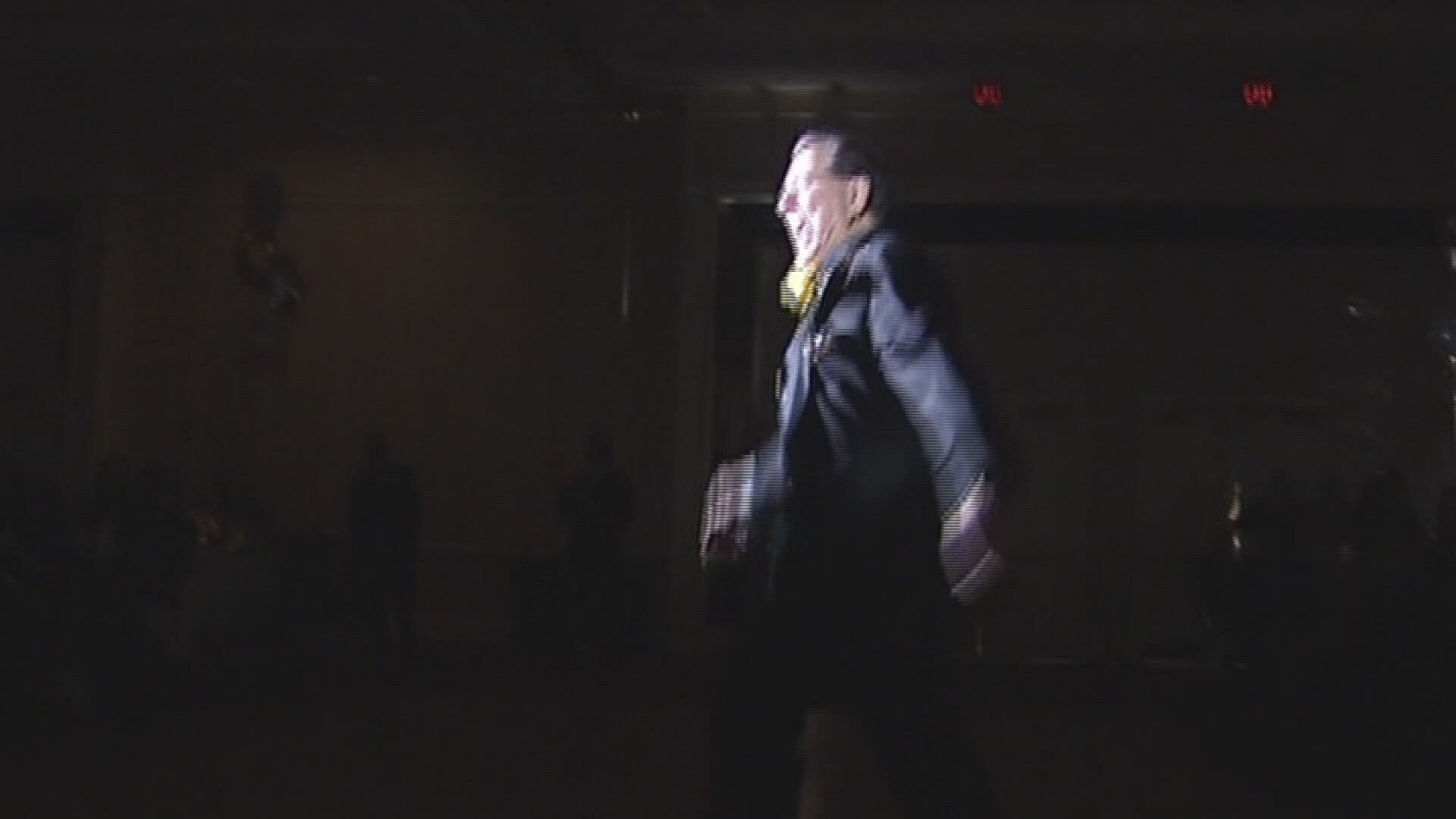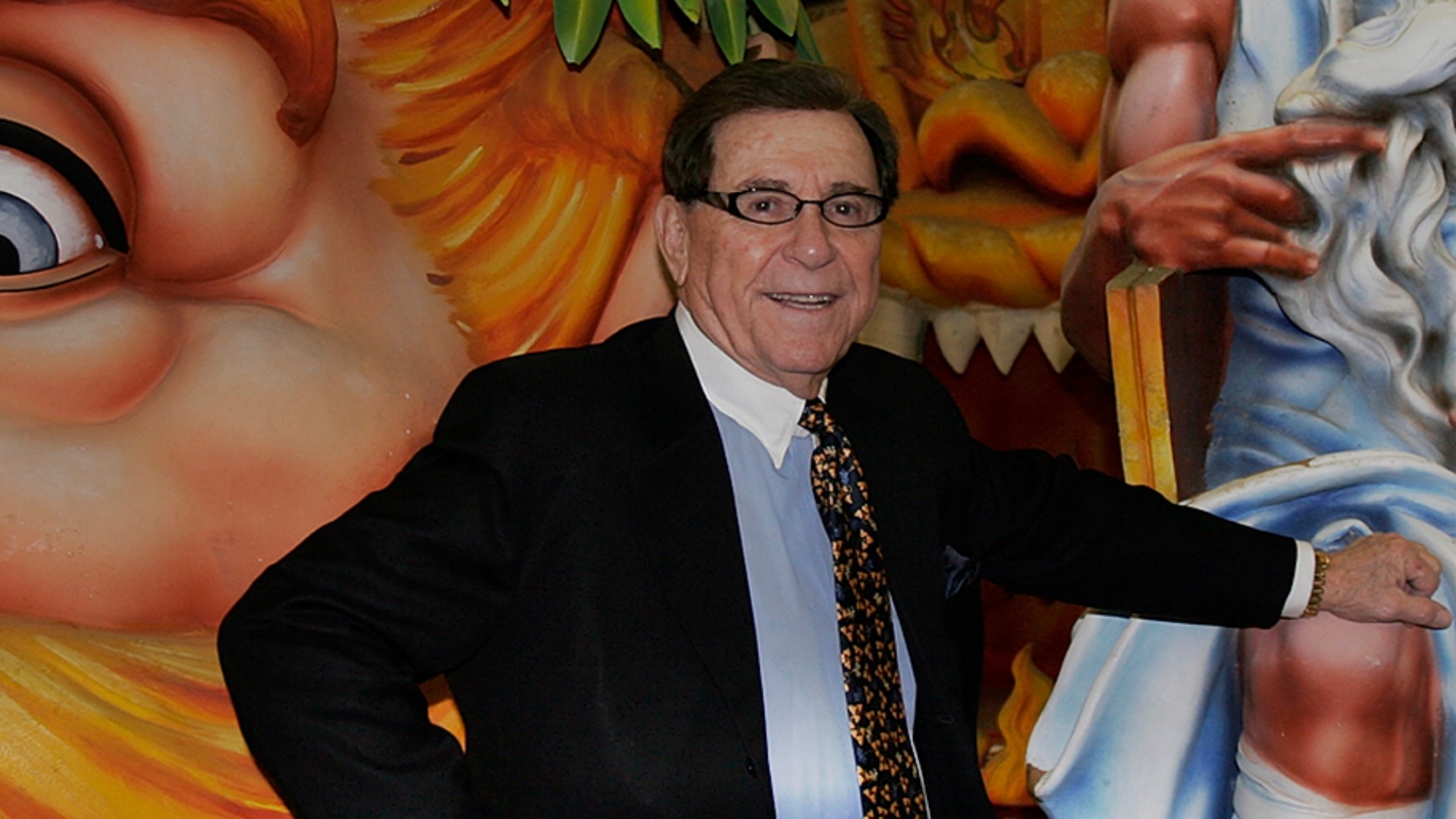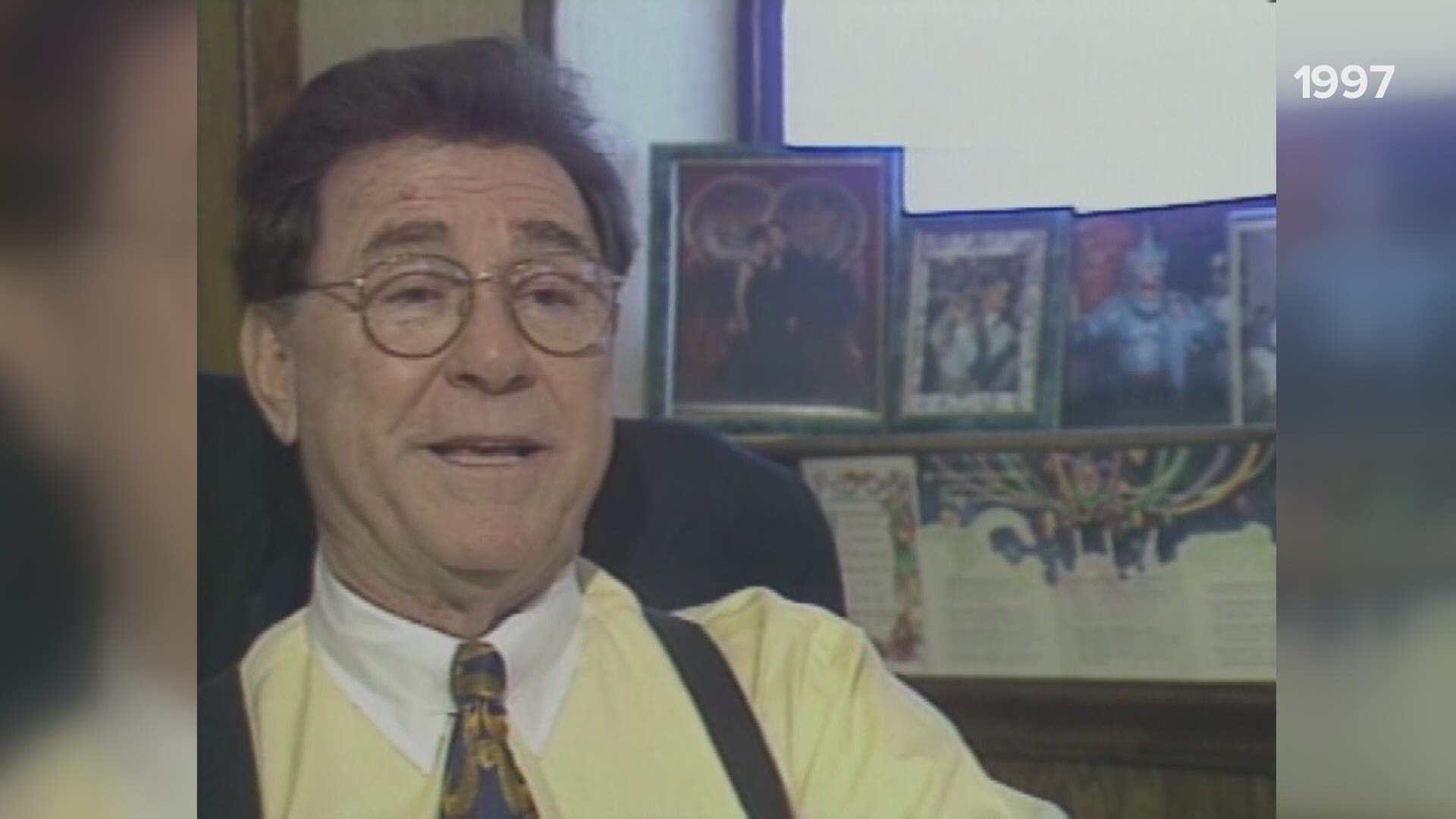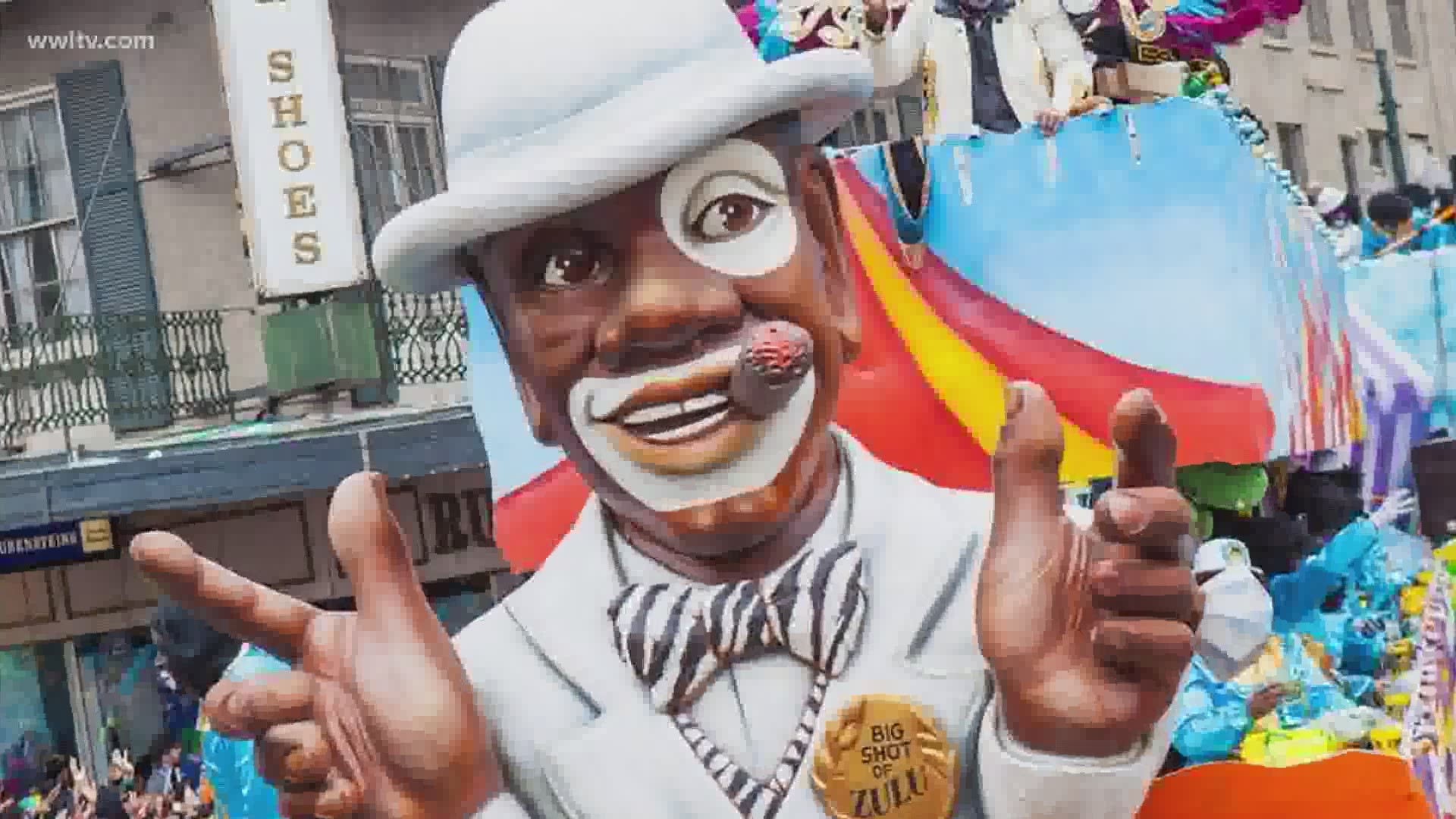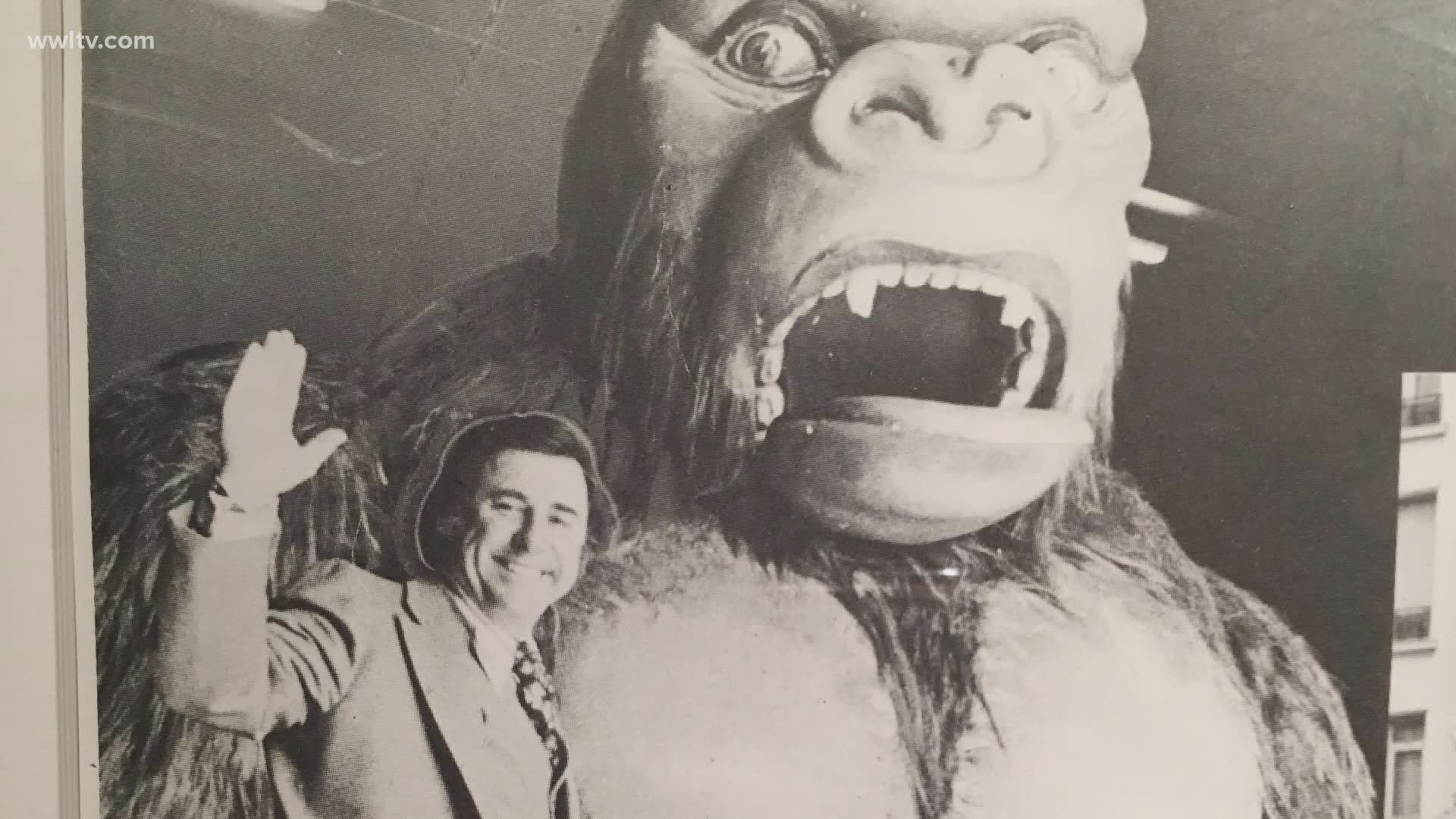NEW ORLEANS — Blaine Kern Sr., the legendary artist and high energy entrepreneur who turned Mardi Gras float building into a multimillion-dollar business, playing a pivotal role in New Orleans Carnival for more than 65 years, died Thursday, according to his wife Holly. He was 93.
Kern is widely recognized as one of the most important figures in 20th century Mardi Gras. The company he founded as Blaine Kern Artists in 1947, now known as Kern Studios, became known for designing and building parades for the biggest and best-known krewes, including Rex, Zulu, Bacchus, Endymion, Orpheus and Muses. Because of that, Rex gave him the title “Mr. Mardi Gras” in 1988 and Kern, ever the shrewd businessman, trademarked it.
“I bring happiness to millions of people every year,” he said in a 1997 WWL-TV interview. “Everybody’s got a big grin on their face, everybody’s smiling and shouting and having fun, so I figure I’m bringing joy and fun to millions of people.”
Kern and his team introduced numerous parade innovations such as double-decker floats, multi-unit tandem floats, giant animated prop figures, splashy lighting and animatronics. The most recognizable floats in modern Mardi Gras are all Kern creations – including Rex’s Boeuf Gras, Jester and King’s float; the Bacchus King Kong family, Bacchagator and Bacchasaurus; the Orpheus Leviathan and Smokey Mary; signature floats for Endymion and Muses; and the floats that carry Zulu’s king and hierarchy of characters.
The artists and craftspeople of the company he created, Kern Studios – now overseen by his son Barry – also produce parades for nearly a dozen other krewes in the metro New Orleans area and along the Gulf Coast. They also produce parades, floats, figures and props for Universal Studios, the Walt Disney Company, Six Flags and commercial clients and theme parks worldwide. Kern liked to say that every day, somewhere on the planet, a Blaine Kern parade was rolling through the streets.
Born in Algiers in 1927 – “a ninth generation Algerine," as he called himself – Kern had a lifelong interest in art, first sparked by his father, Roy, a sign painter.
"I was always going to be an artist, I was always in trouble, all I ever did in school was read books and draw pictures. I was at the bottom of the class, honest to goodness, never got past high school,” he told WWL-TV’s Bill Capo in 2007.
A childhood illness kept Kern from playing outside, so he explored distant worlds through reading. It sparked an imagination that would fuel him throughout his life. “I read H.G. Wells, Arthur Conan Doyle, Jules Verne, Edgar Rice Burroughs. I was going to the moon before Sputnik,” he said in 2017. “My imagination is off the wall. I dream to this day… I’ve got ideas yet that I want to do. I won’t even tell you because they’re that good!”
Kern studied art with renowned artists John McCrady and Leonard Flettrich, but wasn’t sure he could make a career for himself as an artist. When he returned home after serving in the army during World War II, his mother needed medical treatment. He met Dr. Henry LaRocca, the captain of the Krewe of Alla, which Kern’s father had built floats for a decade earlier.
"I painted a mural for him to pay mom’s doctor bill, and he liked me and said, ‘Son, do you think you could design and paint a parade?’” Kern said. “I was not quite 20 at the time and thought I could do anything. The only reason I got the job was my father guaranteed he would finish the job if I couldn't.”
That first parade he created for Alla, which takes its name from Algiers, Louisiana, earned Kern rave reviews. “All of a sudden, everybody in New Orleans was talking about how the poor people in Algiers had nicer floats than what was going down St. Charles Avenue,” said Barry Kern.
Propelled by that success, Kern soon formed an association with the Rex parade that helped grow his business and his reputation even more. The then-captain of Rex, Darwin Fenner, learned of Kern’s talents and recruited him to work on the Rex parade in the early 1950s. Fenner used his own money to send Kern to Carnival celebrations across the globe. From float builders and artists in Italy, France, Germany and Spain, he learned techniques and styles he would use to transform the New Orleans Carnival.
“I went over there, I learned how to make molds, how to mix pigments and brought all those ideas back, showed my guys here and the rest is history,” Kern said. “All of a sudden we were using these three-dimensional figures and bas relief figures, flowers and leaves. It went crazy.” Kern and his company would go on to design and build the Rex parade for more than 65 years, up until 2019.
Kern’s success with revitalizing the Rex parade and designing Alla, of which he later became the longtime captain, even caught the attention of Walt Disney. During a visit to Mardi Gras, Disney was impressed with one of Kern’s creations for Alla: an 18-foot-tall animated King Kong figure. Disney featured the gorilla on his television program and offered Kern a job in Los Angeles.
“I came home and told Darwin Fenner, ‘I’m going to Hollywood, going to work for Walt Disney.’ Disney was like a god to me,” Kern explained in a 2017 interview with Dennis Woltering. “Mr. Fenner said, ‘Son, let me tell you something. You go to Hollywood, you’re going to be a little fish in a big, big pond. But Mardi Gras is going to grow and if you stay here you’re going to be a big fish in a little pond.’ And of course he was so right. It was like dynamite – everything exploded after that.”
In 1968, Kern would play a key role in founding the Krewe of Bacchus. The parade was formed by leaders of the hospitality industry who felt that Mardi Gras parades in the 1960s had become somewhat tired and the celebration was losing its appeal as a tourist attraction. Founding captain Owen “Pip” Brennan Jr. and costume designer Larry Youngblood approached Kern with their idea for a krewe that would feature supersized floats with large, animated figures and a celebrity king.
“Blaine was so talented. He was so far ahead of his time,” Brennan said. “In less than ten days, he came back with the drawing of each float, how it fit the theme, the colors, everything and Bacchus was born.”
Kern’s brash and braggadocious style fit perfectly with the founders of Bacchus, but not with some members of the Carnival establishment who felt the new krewe would outshine their old-line parades. “They said the king of Bacchus would overshadow the king of Mardi Gras,” Brennan said.
Despite that, Kern and Bacchus rolled on and when the krewe’s first parade premiered on the Sunday night before Mardi Gras 1969, with Danny Kaye as its celebrity king, it was an instant hit.

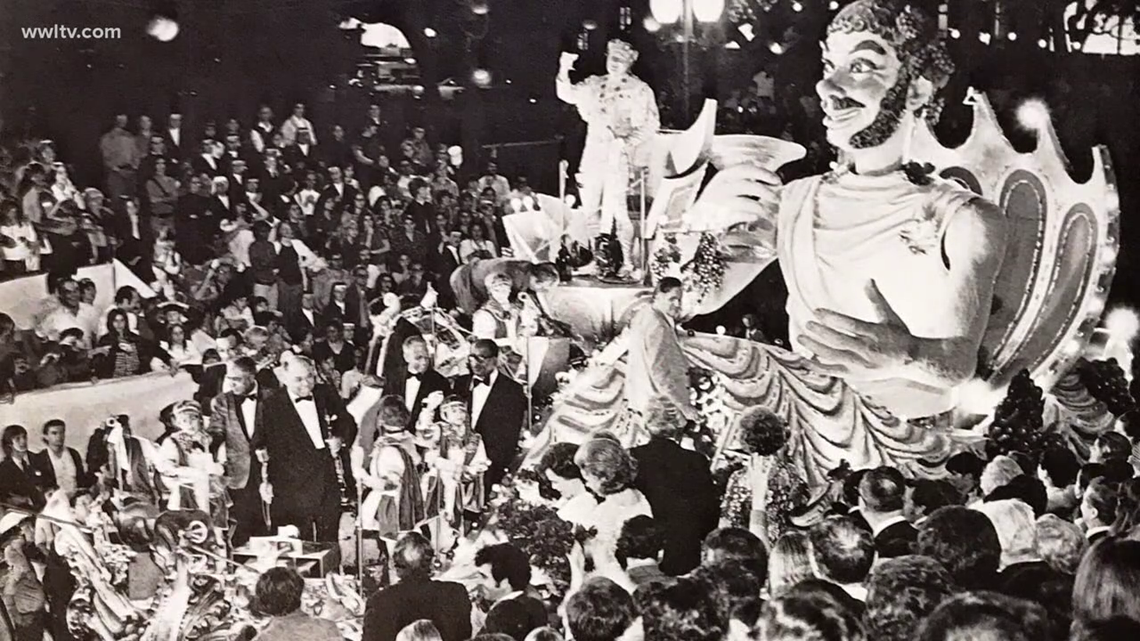
“Blaine had the vision and the imagination and was so enthusiastic,” Brennan said. “We were also the first group to ever turn Blaine loose, so to speak, where money was not an object and for the first time in his Mardi Gras life, he was able to do some things he always dreamed about with floats.”
Kern would introduce the tandem, or multi-unit, float in Bacchus, with the Bacchagator in 1986. The 105-foot, three piece float can accommodate 86 riders. It was the first of many tandem floats to be used in Carnival. Kern’s fascination with King Kong, which caught Walt Disney’s eye in the 1950s, made a return in Bacchus, with a King Kong float, introduced in 1972. It was followed by Queen Kong in 1973 and Baby Kong in 1982.
For Bacchus, Kern also came up with the idea of rolling the parade floats into the Rivergate convention center, for the post-parade party called the Bacchus Rendezvous. In 1973, when Bob Hope was Bacchus, Kern’s guests at the Rendezvous included Ed Muniz and his wife, Peggy. Seven years earlier, Muniz had founded Endymion as a small Gentilly neighborhood krewe. Experiencing the fun of a spectacular Bacchus parade at the Rivergate gave Muniz big, new ideas. “It was magical,” Muniz said in a 2016 New Orleans Advocate article. “I was impressed. I told Blaine, ‘I really like what they’re doing.’"

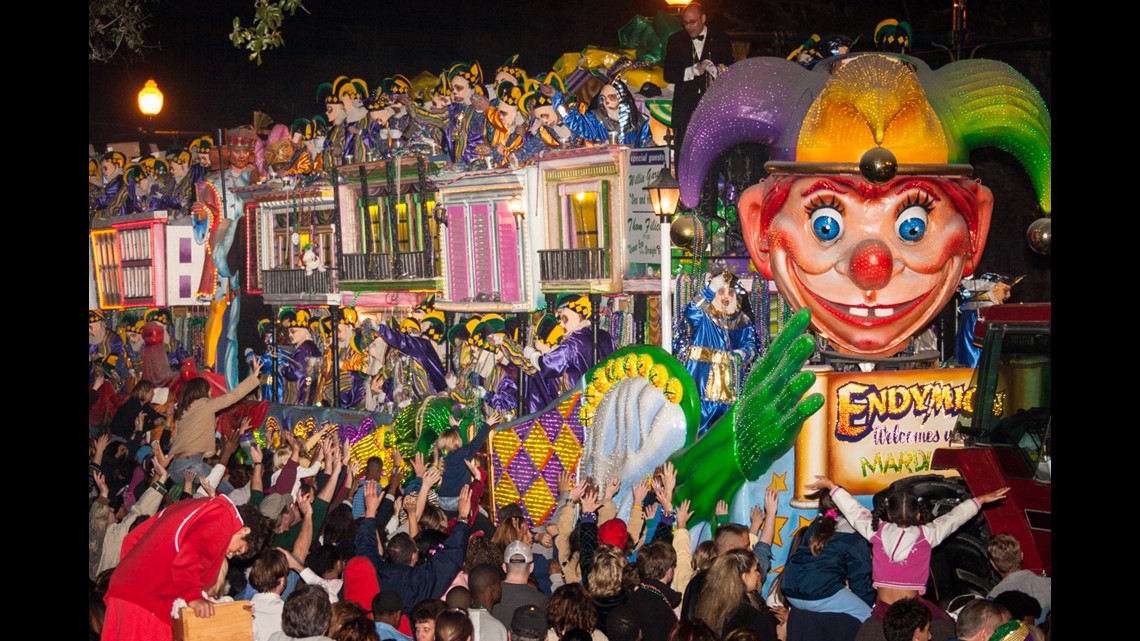
With Kern’s help, and Muniz as captain, Endymion would become Mardi Gras’ biggest parade. The krewe now boasts some of the longest and most elaborate floats in Carnival, including “Captain Eddie’s S.S. Endymion,” the “Endymion Welcomes You to Mardi Gras” float and the “Pontchartrain Beach Then and Now” float. Billed as the biggest and most expensive float in all of Mardi Gras when it debuted in 2013, the Pontchartrain Beach float cost more than $1.5 million to create and carries more than 250 riders over nine sections.
“Ed had a vision to be the biggest and best, and Blaine fed that vision, because he wanted to build it,” said Endymion vice president Darryl d'Aquin in a 2018 Times-Picayune article. “So they fed off each other.”
With Endymion, Bacchus and other krewes with whom he worked, Kern said he was most proud of his role in opening Carnival to people of all races, ethnicities and economic levels, who could become members of the new krewes. “Up until then, it was closed, you had to be a WASP. You couldn’t be Italian or Jewish or even black. You couldn’t join these krewes. What I did was open up Mardi Gras to everyone,” he said.
Further, by renting floats to smaller krewes, many of them in the suburbs, Kern introduced new ways for people to participate in parades. “He brought Mardi Gras to the masses,” said Barry Kern. “He built rental floats that were then shared by different organizations and he had the tractors and the equipment so it allowed krewes that didn’t have enough money to own their floats to put on parades as well, so that changed Mardi Gras very much.”
In the 1990s, Kern would help Harry Connick Jr. create a new super krewe, Orpheus, which also boasted that its membership would be open to men and women of all races, including out-of-town riders. For Orpheus, Kern created another dazzling float, the 120-foot Leviathan, an animated sea serpent decorated with multicolored fiber-optic lights (a first for Mardi Gras), sound effects and smoke. Carnival crowds were again blown away. “Instead of just yelling ‘Throw me something,’ they started clapping and cheering – clapping for the float,” Kern said.
In 2000, he helped the founders of the Krewe of Muses create a new night parade for women, which has grown into a Carnival mainstay. “Blaine loved our ideas, so of course we loved that, and I think he appreciated our creativity and the fact that we brought a different point of view that had not really been seen before,” said Muses captain Staci Rosenberg.
A flashy and colorful impresario and born salesman who embodied the terms high energy and fast-paced, Kern was always moving to the next idea, whether it involved Mardi Gras or not. “I dream in Technicolor,” he said, in 2017. “I get ideas all the time, to this day!”
“I say he’s a combination of Michelangelo and P.T. Barnum,” said Carnival historian Errol Laborde, editor of New Orleans Magazine. “Michelangelo because he is a great artist and P.T. Barnum because he was always the huckster, always able to go out and promote things and say, ‘Let’s go one step bigger.’”
In one memorable example, he went bigger and higher. For the 1984 World’s Fair, Kern introduced the gondola, part of the $12 million MART (Mississippi Aerial River Transit) system. For the price of a $3.50 ticket, fairgoers were carried across the Mississippi River in one of 53 six-passenger cars strung from cables suspended above the river. In a Times-Picayune article, Kern explained it as a “combination thrill ride and practical commuter vehicle” which he hoped would carry passengers across the river long after the fair closed. The project cost Kern millions when the fair flopped financially.
For the World’s Fair, Kern is also remembered for creating the whimsical Wonder Wall that outlined the fair site and the giant sculpted figures of a buxom mermaid, sea god Neptune and alligators that graced the fair’s entrance.

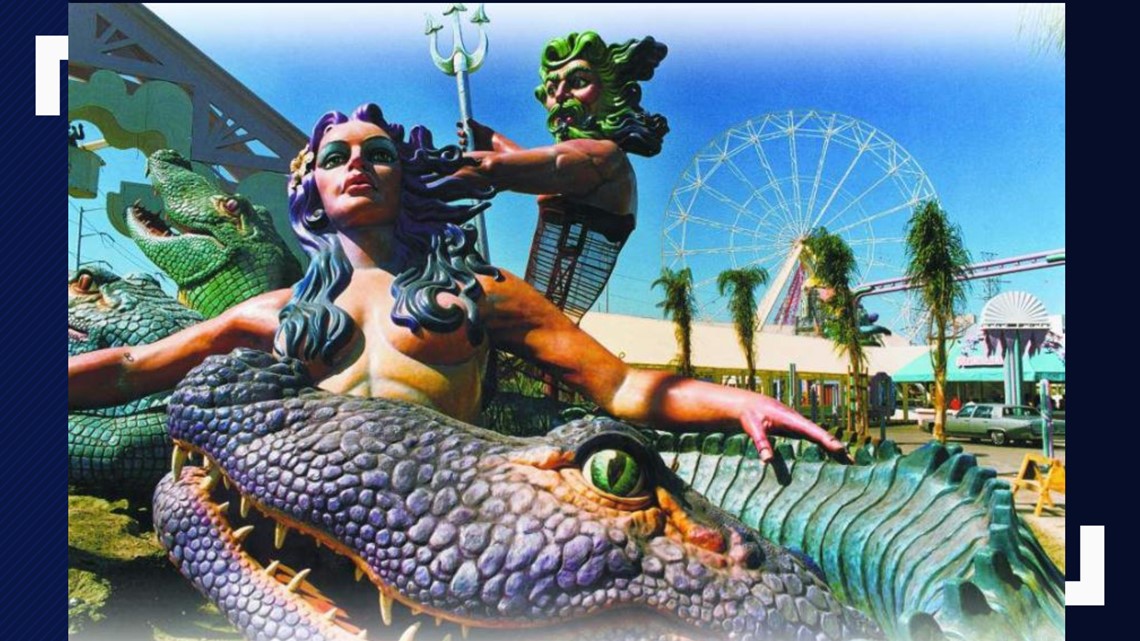
Kern admitted that some of his other ideas also failed to succeed or never made it off the drawing board. In the 1980s, he bought a decommissioned Naval aircraft carrier, the USS Cabot, which had been purchased by the Spanish government. In some retellings of the story, Kern said he paid $1 for the ship; in others, a nickel, illustrating his penchant for exaggeration.
Kern planned to turn the ship into a museum and casino docked at his Mardi Gras World facility in Algiers. He paid nearly $350,000 for fuel to bring the carrier to New Orleans, where it sat on the Algiers riverfront for years. After Kern failed to secure a casino license for the ship, it was sold for scrap.
Following Hurricane Katrina, Kern staged the Krewe of Boo Halloween parade and a haunted house and party to benefit first responders. The krewe is now overseen by his son Brian.


"Let's face it honey, the only way I know how to make money is to throw a party," Blaine Kern told The Times-Picayune in 2007. "We're going to make New Orleans the number one Halloween destination in the country. Not only will our party be among the biggest in the world, this will be a party with a purpose."
Friends and family said Kern’s charm and hyper enthusiasm, combined with his artistic skill, powered his ability to sell his ideas and grow his business. “I think it was his ability to not just envision and see something but also draw it,” said his son Blaine Kern Jr. “His ability to sell people on it is an amazing attribute. It’s one thing to create a design. It’s something else to have other people believe in what you see.”
For the latter part of his career, Kern oversaw a list of companies later run by his children, including Blaine Kern Artists, Kern Studios, Kern Sculpture (all run by son Barry) and Mardi Gras Productions, with Blaine Jr. as president and CEO. He also expanded the riverfront tourist attraction Mardi Gras World, which opened in 1984 in Algiers and moved to its current site near the Ernest N. Morial Convention Center in 2008. Mardi Gras World turned Kern’s float building dens into year-round tourist attractions. The facility is now also a major special event and entertainment venue.

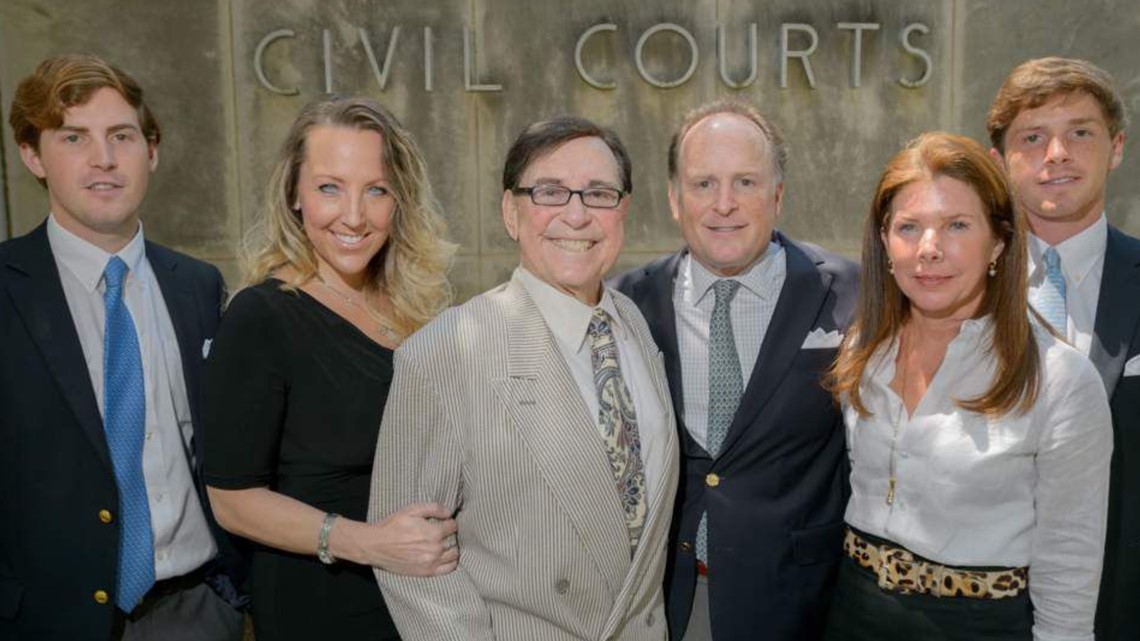
The Kern family ties were tested in 2010, when a dispute between Blaine and Barry Kern thrust the company’s finances into the spotlight, as father and son wrestled over the question of who should run the family business. Barry Kern sued his father for control of the company, leading to a five-year court fight that both sides eventually agreed to dismiss. Blaine Kern sold his 50.1 percent stake in the company to Barry.
Though Kern entered retirement at that point, his creative mind never slowed, with his energy impressing and outmatching friends half his age. Visitors to the West Bank house he shared with his fourth wife, Holly, whom he married in 2010, were greeted by a figure of Peter Pan – the fictional free spirit who never grows up.
Kern came close to death several times in his life. Before he got a pacemaker in 2008, Holly resuscitated him with CPR at least three times. In the 1990s, he suffered a heart attack on his way into open-heart surgery and had to be revived.
“You know, it was the prayers at work,” Kern said in 2007. “So many people prayed for me. It made me feel small in a way – all the attention –I didn’t feel worthy. But I felt wonderful about it. It was a very humbling experience.”
Following the ordeal, Kern increased his philanthropic giving, with Catholic Charities, the Little Sisters of the Poor and Holy Name of Mary School among those benefitting from his generosity. Our Lady of Holy Cross College in Algiers (now the University of Holy Cross) named its library after him in recognition of his support.


His wife Holly, with whom he traveled to more than 70 countries, also encouraged Kern to renew his passion for art and drawing. His illustrations brought her idea for a children’s book to life when "A Tree in the Sea” was published in 2017.
In addition to his wife, Kern is survived by five children: Blaine Jr., Thais, Barry, Brian and Blainey; as well as 10 grandchildren and one great-grandchild.
- With reporting by Dennis Woltering
► Get breaking news from your neighborhood delivered directly to you by downloading the FREE WWL-TV News app now in the IOS App Store or Google Play.

